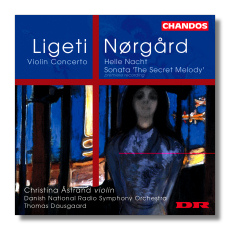
The Internet's Premier Classical Music Source
Related Links
- Ligeti Reviews
- Latest Reviews
- More Reviews
-
By Composer
-
Collections
DVD & Blu-ray
Books
Concert Reviews
Articles/Interviews
Software
Audio
Search Amazon
Recommended Links
Site News
 CD Review
CD Review
György Ligeti & Per Nørgård

Violin Concertos
- György Ligeti: Violin Concerto
- Per Nørgård:
- Helle Nacht (Violin Concerto)
- Sonata "The Secret Melody"
Christina Åstrand, violin
Danish National Radio Symphony Orchestra/Thomas Dausgaard
Chandos CHAN9830 DDD 67:41
Both of the main works involve exploration of alternative tunings. In György Ligeti's concerto, completed in 1992, the brass are asked to play in natural harmonics, thereby producing notes not included in the equal-tempered scale. Solo orchestral strings also play harmonics, the winds bend their pitches, and instruments of indistinct pitch (ocarinas or "sweet potatoes," slide whistles) are added to the orchestra. In his concerto, which was completed in 1987, Nørgård asks instruments to mistune, producing interference waves, heard as "beats," when one slightly "off pitch" note plays against its "on pitch" relative. For example, if an A of 440 Hz is played at the same time as an A of 444 Hz, pulsating interference waves are created; the tempo of the beats increases as the interval between the two frequencies decreases. This effect also occurs at octaves; for example, an A of 220 Hz played with an A of 444 Hz also will create audible interference waves or beats.
The two concertos are complementary but dissimilar. Ligeti's work, while lacking anything that might be described as slapstick, and not as outlandish as his earlier masterpieces, is full of his characteristic dry humor. When Ligeti uses learned techniques, including intentional mistunings, he seems to be mocking academic pomposity, not perpetuating it. The chorale for ocarina quartet is only the most obvious example of this. Throughout, the Ligeti concerto is music of insect activity and mystery. The Nørgård concerto, subtitled "Light Night," also is mysterious, but its contours are less precisely defined. In keeping with its title, the Nørgård concerto is suffused with an austere yet soft light, and numerous fuzzily interlocking layers. The title's allusion to the short and light summer nights in the far north really describes the concerto well.
The Secret Melody is a sequel of sorts to Nørgård's concerto. He wrote it in 1992 for solo viola; later, it was arranged (not by the composer, but with his approval) for solo violin, which is how it is played here. The composer says the five brief movements "circumscribe a hidden melody: a clear melodic shape appears often enough, but it soon reveals itself as being part of another, superior melody – and so on." Whatever that means, it is an attractive work, but it is an anticlimax after the two concertos.
Åstrand plays these three works brilliantly. In the Ligeti, where she has more competition, she impresses with her passion as well as with her technique. The Danish orchestra understands the stylistic differences between Ligeti and Nørgård, and it plays very effectively, with fine advocacy from Dausgaard. Chandos' characteristically excellent sound – and an appropriate cover painting from Edvard Munch – completes a highly worthwhile release. Recommended.
Copyright © 2001, Raymond Tuttle


















